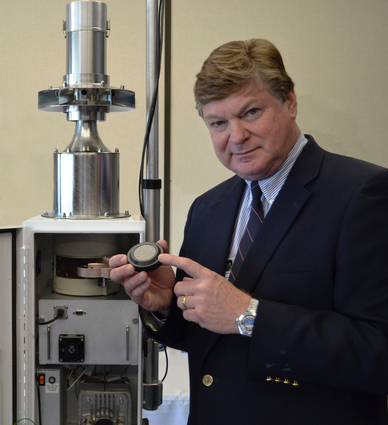Homann receives Secretary of Energy award
 (Download Image)
(Download Image)
LLNL's Steve Homann, who is serving as the Department of Energy's senior science adviser for the NASA Mars Science Laboratory mission, holds a filter for an Environmental Continuous Air Monitor (shown in the background).
This award is bestowed on a group or team of employees who together accomplished significant achievements on behalf of the Department of Energy. These groups demonstrated cooperation and teamwork in attaining their goals.
Between late June and late November of 2011, the MSL MMRTG team delivered the multi-mission radioisotope thermoelectric generator for NASA's Mars Science Laboratory mission, which launched on Nov. 26, 2011.
About the size of a small jeep, the Mars Science Laboratory carried the largest and most technologically advanced rover -- dubbed "Curiosity" -- ever sent to another planet. Landed on Mars Aug 5, 2012, the rover relies upon the radioisotope thermoelectric generator, essentially a nuclear battery, with 10.6 pounds of plutonium-238 dioxide that converts heat into electricity. The battery gives Curiosity its onboard power and warms its internal systems during the frigid Martian nights, where temperatures can dip as low as -238 degrees Fahrenheit .
As senior science adviser, Homann played a lead role in one of the most comprehensive radiological emergency preparedness systems to monitor a NASA launch. In preparation for the launch, NASA installed 30 radiological monitors -- called Environmental Continuous Air Monitors, or ECAMs -- on and around the Kennedy Space Center. The detector looks for the unique signature of plutonium-238.
With coordination from LLNL, the ECAMs monitor the air for the release of any radioactivity in the event of a launch accident involving the spacecraft. The ECAM units, located from near Titusville, Fla. in the north to Melbourne in the south, simultaneously transmit real-time data via satellite to the Kennedy Space Center's Radiological Control Center and to LLNL's National Atmospheric Release Advisory Center.
"In the unlikely event of a launch mishap, people will want to know whether there is a health and safety hazard with airborne plutonium," Homann said. "With the ECAMs units, we are able to establish whether we see any radiation levels above the natural background radiation."
The team members, including Homann, received their awards last month via satellite broadcast of DOE's 35th Anniversary celebration and Secretarial Honor Awards Ceremony.




